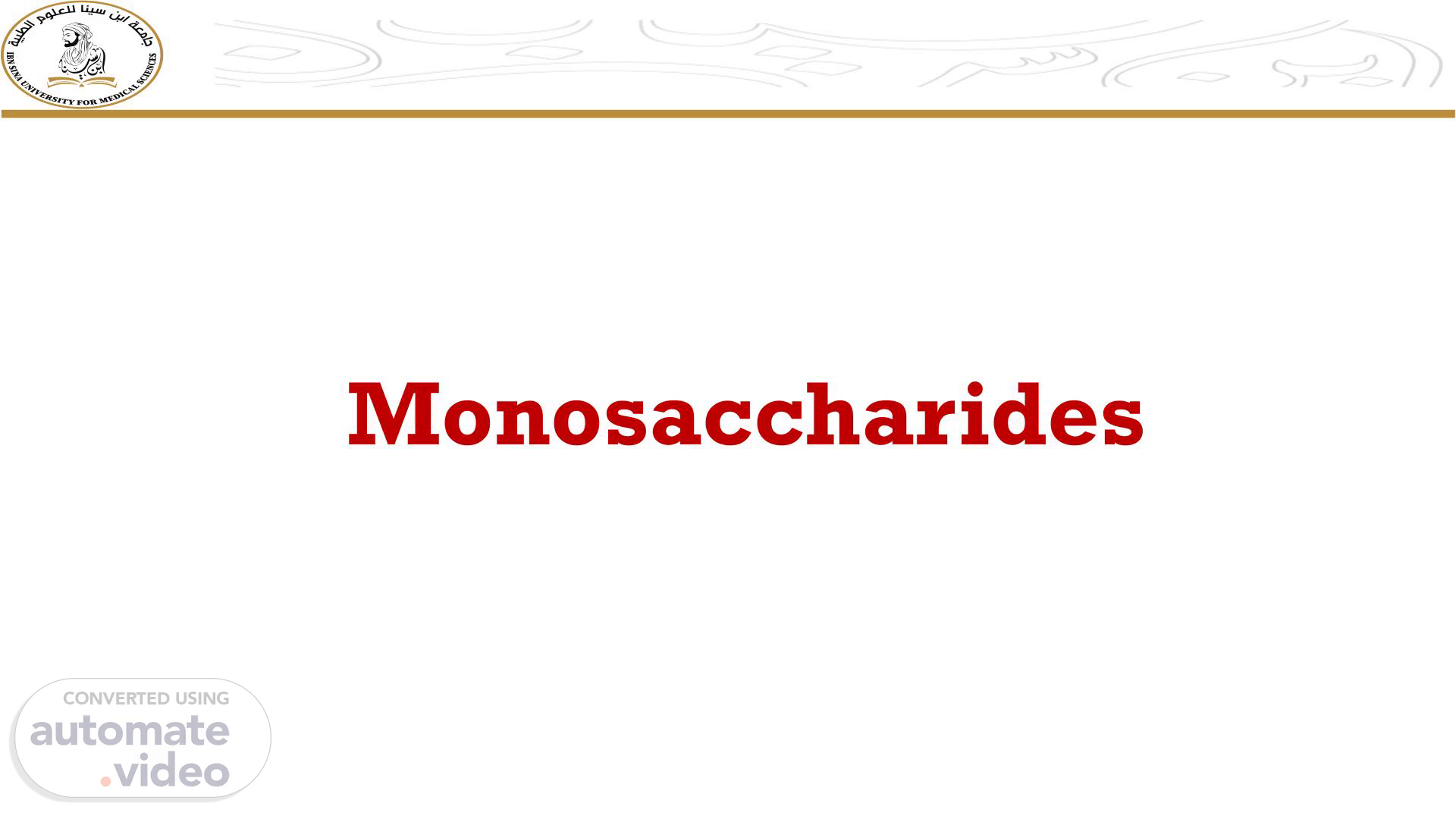Scene 1 (0s)
Monosaccharides.
Scene 2 (5s)
Prof / Ayman El Baz Professor of Medical Biochemistry & Molecular Biology Dr/ Sara EL Derbaly Assistant Professor of Medical Biochemistry & Molecular Biology.
Scene 3 (15s)
➢ By the end of the lecture, the students should be able to: • Define Carbohydrates • Classify carbohydrates • Identify the different types and structure of monosaccharides • Understand biological importance of monosaccharides • Correlate to clinical conditions Course learning outcomes.
Scene 4 (28s)
Contents Carbohydrates I. Definition II. Classification Monosaccharides I. Definition II. Classification III. Monosaccharides of biological importance.
Scene 5 (36s)
Case scenario • Hossam is a 45 years old male patient, presented to the emergency room (ER) with complaints of fatigue, dizziness, pale skin, sweating, headache and rapid heartbeats. • On examination: The patient was conscious but anxious and had profuse cold sweat. The blood pressure was 110/70 mmHg, heart rate: 98 BPM and random blood sugar was 59 mg/dl..
Scene 6 (55s)
Carbohydrates = CHO I. Definition: • Carbohydrates are organic compounds characterized by 3 features: 1.Containing: Carbon, Hydrogen and Oxygen 2.Containing more than one “OH” group (Poly–hydroxyl) 3.Containing free active carbonyl group: aldehyde or ketone group..
Scene 7 (1m 8s)
• They are classified according to the number of sugar units into: 1. Monosaccharides: 1 sugar unit 2. Disaccharides: 2 sugar units 3. Oligosaccharides: 3-10 sugar units 4. Polysaccharides: more than 10 sugar units II. Classification of Carbohydrates.
Scene 8 (1m 22s)
Monosaccharides I. Definition • They are the simplest sugar units that cannot be hydrolyzed into smaller ones..
Scene 9 (1m 30s)
II. Classifications of Monosaccharides: a. According to number of carbon atoms: • Trioses: monosaccharides containing 3 carbon atoms. • Tetroses: monosaccharides containing 4 carbon atoms. • Pentoses: monosaccharides containing 5 carbon atoms. • Hexoses: monosaccharides containing 6 carbon atoms..
Scene 10 (1m 44s)
b. The active (free carbonyl) group: • Aldehyde: (aldoses) • Ketone:(Ketoses).
Scene 11 (1m 53s)
Examples of Monosaccharides No. of carbons Name Aldose (aldosugar) Ketose (ketosugar) 3 Triose Glyceraldehyde Dihydroxyacetone 4 Tetrose Erythrose Erythrulose 5 Pentose Ribose, Xylose Ribulose, Xylulose 6 Hexose Glucose, Galactose, Mannose Fructose.
Scene 12 (2m 2s)
III. Monosaccharides of Biological Importance.
Scene 13 (2m 8s)
1. Glucose (Dextrose) (Grape Sugar): A. It is the principal sugar in the blood. B. It is the primary source for production of energy for most tissues, specially nervous tissue and erythrocytes. C. Ingested carbohydrates are absorbed in the form of glucose..
Scene 14 (2m 23s)
D. Glucose can be converted into other sugars by different metabolic pathways: • Galactose: in mammary gland (Lactose), nervous tissues (Glycolipids) • Fructose: in seminal plasma • Ribose: in all tissues except skeletal muscle • Glycogen: in Liver and skeletal muscle Glucose Fructose Galactose Glycogen Ribose.
Scene 15 (2m 35s)
2. Galactose: • It enters in structure of : a. Lactose (milk sugar): in mammary gland b. Glycolipids, glycoproteins and keratan sulfate. c. Ingested galactose is converted to glucose in the liver..
Scene 16 (2m 47s)
3. Mannose: • Mannose occurs in small quantities in some fruits, vegetables, and in the plant cell walls that contain Mannans. • It enters in the formation of glycoproteins and glycolipids..
Scene 17 (2m 59s)
4. Fructose (Fruit Sugar) • It enters in structure of: a. Disaccharide: Sucrose (Table sugar) b. Polysaccharide: Inulin • It is the sugar of seminal plasma (Sperms utilize fructose for energy production) • Ingested fructose is converted to glucose in the liver..
Scene 18 (3m 13s)
5. Ribose and Deoxyribose • They are pentoses that enter in the structure of: a. Nucleic acids: DNA & RNA b. High energy phosphate compounds: ATP c. Co-enzymes: NAD and NADP d. 2nd messenger for hormonal action: cAMP e.Vitamins: Riboflavin.
Scene 19 (3m 27s)
Case scenario • Hossam is a 45 years old male patient, presented to the emergency room (ER) with complaints of fatigue, dizziness, pale skin, sweating, headache and rapid heartbeats. • On examination: The patient was conscious but anxious and had profuse cold sweat. The blood pressure was 110/70 mmHg, heart rate: 98 BPM and random blood sugar was 59 mg/dl..
Scene 20 (3m 45s)
Q1. Which condition best explains the symptoms and laboratory findings? Q2. What is the main fuel for human body cells? Q3 What are the tissues that depend on it as a primary source of energy? Q4. What is the normal value of fasting, 2-hour postprandial and random blood glucose?.
Scene 21 (4m 0s)
de Od4/ eteoe'.
Scene 23 (4m 12s)
• Vasudevan’s Textbook of Biochemistry For Medical Students (60-67), 10th Edition. • Lippincott Illustrated Reviews Textbook of Medical Biochemistry, 8th Edition. References.
